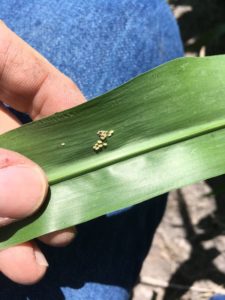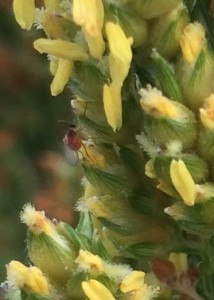Sorghum fields in Calhoun, Refugio and Victoria Counties should be scouted weekly for pest insects. This is especially true for the Sugarcane Aphid and Sorghum Midge. We have ben finding sugarcane aphids in sorghum fields across the area but their numbers have been below threshold levels thus far.
I have seen only occasional plants along the southern edge of sorghum fields with sugarcane aphids. The most I have seen thus far is small colonies of less than 20 aphids on a less than 1% of plants.
When scouting sorghum fields, I suggest marking plants containing sugarcane aphids and returning to these plants twice a week. Continue to check adjacent plants and other parts of the field for additional aphid colonies.
Sorghum fields that have begun to bloom should be checked for Sorghum Midge.
During the single day of adult life, each female lays about 50 yellowish white eggs in flowering spikelets of sorghum. Eggs hatch in 2 to 3 days. Larvae are colorless at first, but when fully grown, are dark orange. Larvae complete development in 9 to 11 days and pupate between the spikelet glumes. Shortly before adult emergence, the pupa works its way toward the upper tip of the spikelet. After the adult emerges, the clear or white pupal skin remains at the tip of the spikelet. Source
A sorghum midge damages sorghum when the larva feeds on a newly fertilized ovary, preventing normal kernel development. Grain loss can be extremely high.
Economic thresholds for sorghum midge can range from 0.5 to 1.5 per blooming sorghum head. This threshold varies with the cost of control, grain value, and number of blooming heads per acre. The economic threshold calculator can be found here.
When an economic population is found treatment is necessary to prevent economic loss. After treatment monitor the field closely for sugarcane aphids as their number can increase following insecticide applications that impact beneficial insects.

